Marketing Plan: Hertfordshire Business School Singapore Entry
VerifiedAdded on 2022/09/06
|13
|3407
|17
Report
AI Summary
This report details a marketing plan for Hertfordshire Business School's entry into the Singapore market, focusing on launching its "Global market solution" program. It begins with an introduction outlining the report's purpose and objectives. The core of the report involves a thorough analysis of the internal and external environments, employing SWOT and PESTEL frameworks. The SWOT analysis assesses the school's strengths, weaknesses, opportunities, and threats, while the PESTEL analysis examines the political, economic, social, technological, environmental, and legal factors influencing the Singapore market. The report also delves into cultural differences using Hofstede's cultural dimensions to understand Singaporean society. Based on these analyses, the report proposes a product adaptation strategy, including tangible, intangible, and promotional adaptations, to effectively penetrate the Singapore market. The action plan includes detailed steps for market research and strategy development to ensure the program's successful launch.
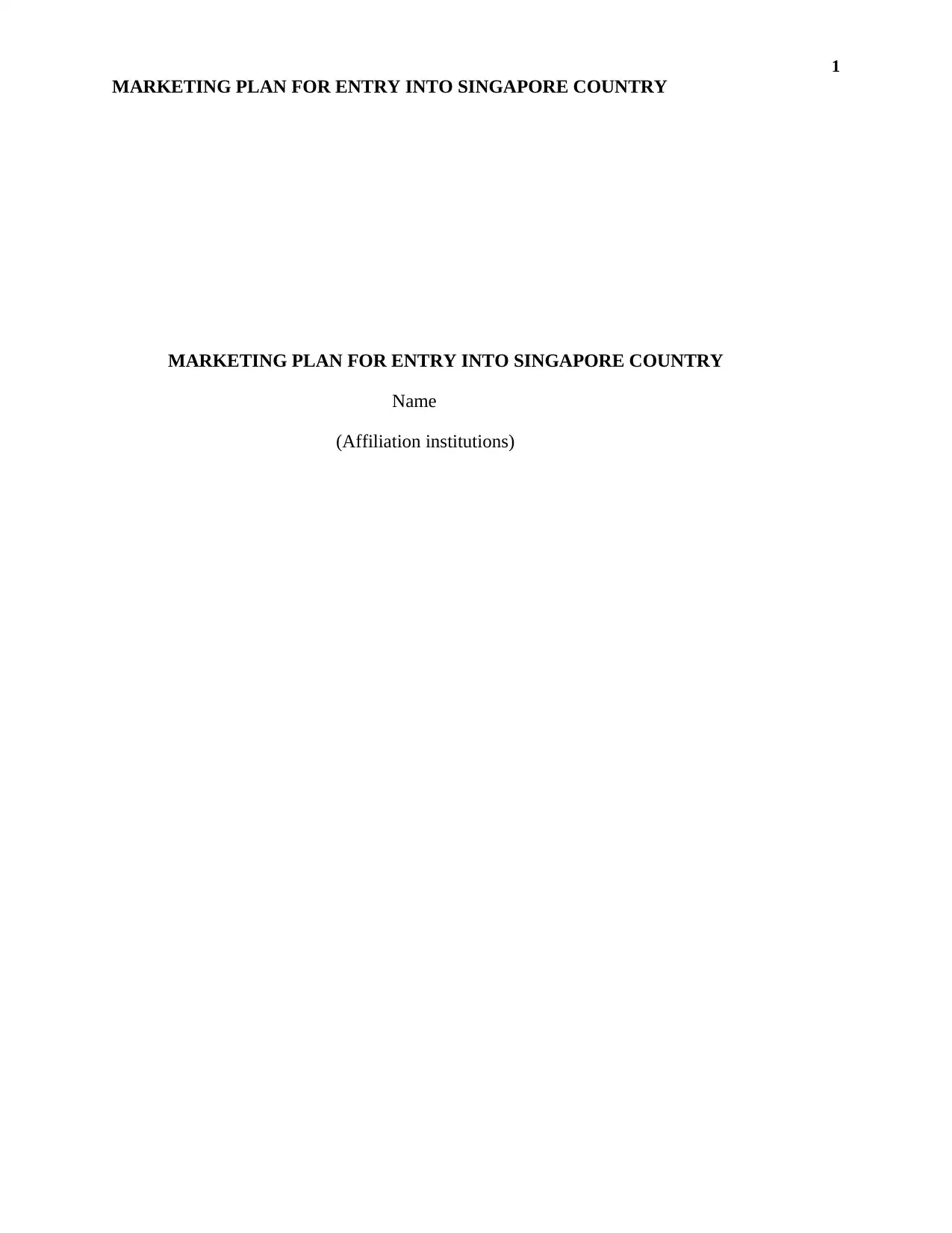
1
MARKETING PLAN FOR ENTRY INTO SINGAPORE COUNTRY
MARKETING PLAN FOR ENTRY INTO SINGAPORE COUNTRY
Name
(Affiliation institutions)
MARKETING PLAN FOR ENTRY INTO SINGAPORE COUNTRY
MARKETING PLAN FOR ENTRY INTO SINGAPORE COUNTRY
Name
(Affiliation institutions)
Paraphrase This Document
Need a fresh take? Get an instant paraphrase of this document with our AI Paraphraser
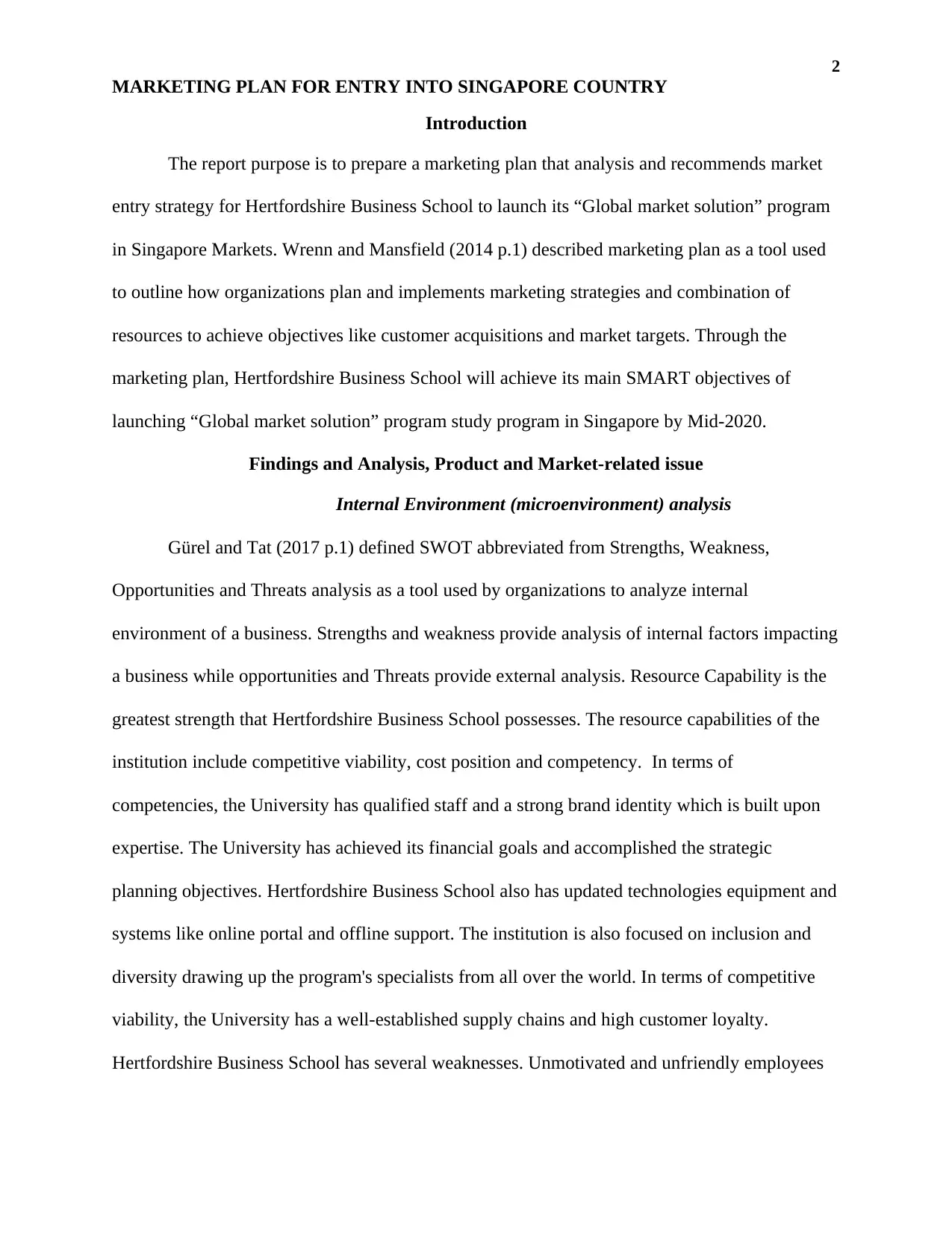
2
MARKETING PLAN FOR ENTRY INTO SINGAPORE COUNTRY
Introduction
The report purpose is to prepare a marketing plan that analysis and recommends market
entry strategy for Hertfordshire Business School to launch its “Global market solution” program
in Singapore Markets. Wrenn and Mansfield (2014 p.1) described marketing plan as a tool used
to outline how organizations plan and implements marketing strategies and combination of
resources to achieve objectives like customer acquisitions and market targets. Through the
marketing plan, Hertfordshire Business School will achieve its main SMART objectives of
launching “Global market solution” program study program in Singapore by Mid-2020.
Findings and Analysis, Product and Market-related issue
Internal Environment (microenvironment) analysis
Gürel and Tat (2017 p.1) defined SWOT abbreviated from Strengths, Weakness,
Opportunities and Threats analysis as a tool used by organizations to analyze internal
environment of a business. Strengths and weakness provide analysis of internal factors impacting
a business while opportunities and Threats provide external analysis. Resource Capability is the
greatest strength that Hertfordshire Business School possesses. The resource capabilities of the
institution include competitive viability, cost position and competency. In terms of
competencies, the University has qualified staff and a strong brand identity which is built upon
expertise. The University has achieved its financial goals and accomplished the strategic
planning objectives. Hertfordshire Business School also has updated technologies equipment and
systems like online portal and offline support. The institution is also focused on inclusion and
diversity drawing up the program's specialists from all over the world. In terms of competitive
viability, the University has a well-established supply chains and high customer loyalty.
Hertfordshire Business School has several weaknesses. Unmotivated and unfriendly employees
MARKETING PLAN FOR ENTRY INTO SINGAPORE COUNTRY
Introduction
The report purpose is to prepare a marketing plan that analysis and recommends market
entry strategy for Hertfordshire Business School to launch its “Global market solution” program
in Singapore Markets. Wrenn and Mansfield (2014 p.1) described marketing plan as a tool used
to outline how organizations plan and implements marketing strategies and combination of
resources to achieve objectives like customer acquisitions and market targets. Through the
marketing plan, Hertfordshire Business School will achieve its main SMART objectives of
launching “Global market solution” program study program in Singapore by Mid-2020.
Findings and Analysis, Product and Market-related issue
Internal Environment (microenvironment) analysis
Gürel and Tat (2017 p.1) defined SWOT abbreviated from Strengths, Weakness,
Opportunities and Threats analysis as a tool used by organizations to analyze internal
environment of a business. Strengths and weakness provide analysis of internal factors impacting
a business while opportunities and Threats provide external analysis. Resource Capability is the
greatest strength that Hertfordshire Business School possesses. The resource capabilities of the
institution include competitive viability, cost position and competency. In terms of
competencies, the University has qualified staff and a strong brand identity which is built upon
expertise. The University has achieved its financial goals and accomplished the strategic
planning objectives. Hertfordshire Business School also has updated technologies equipment and
systems like online portal and offline support. The institution is also focused on inclusion and
diversity drawing up the program's specialists from all over the world. In terms of competitive
viability, the University has a well-established supply chains and high customer loyalty.
Hertfordshire Business School has several weaknesses. Unmotivated and unfriendly employees
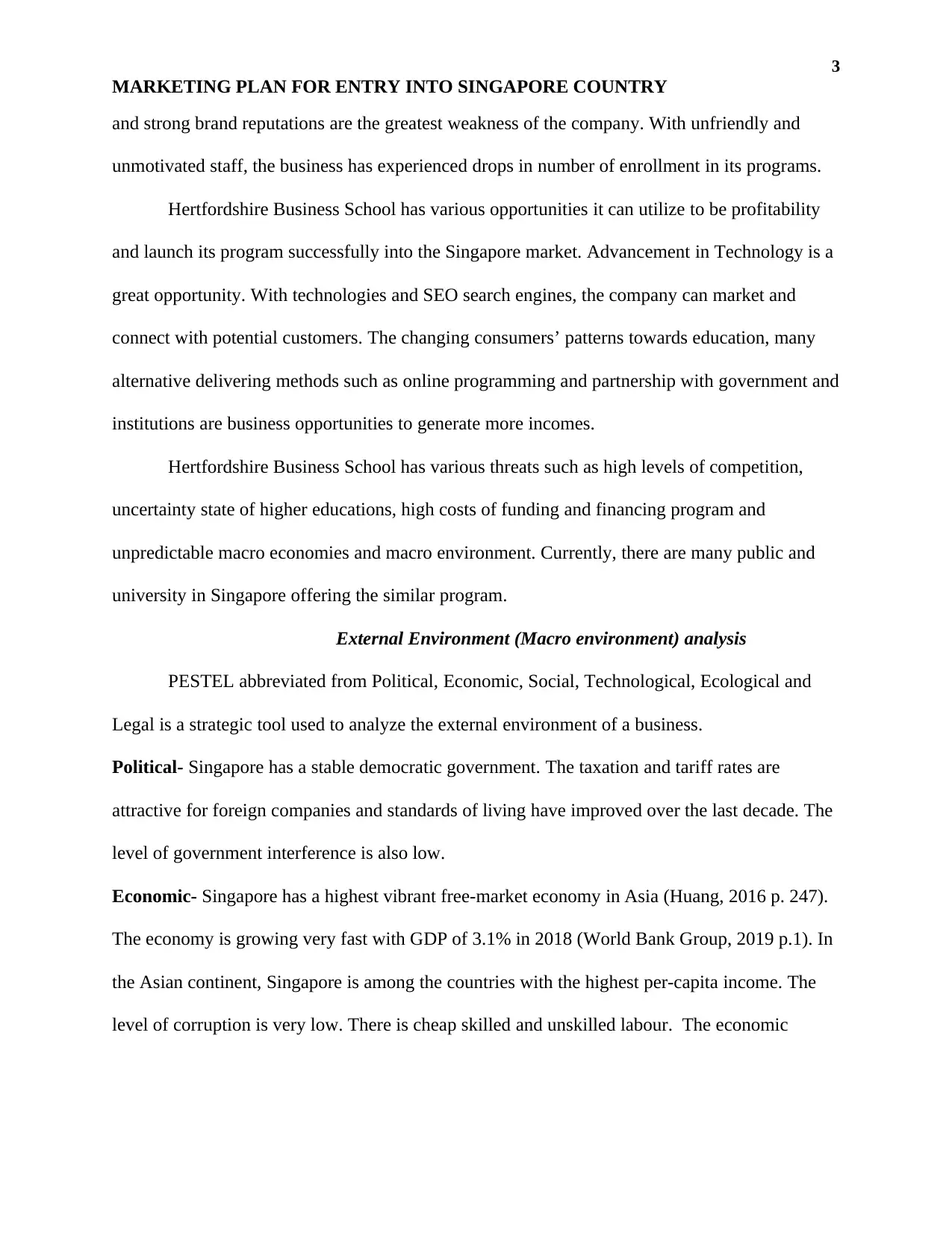
3
MARKETING PLAN FOR ENTRY INTO SINGAPORE COUNTRY
and strong brand reputations are the greatest weakness of the company. With unfriendly and
unmotivated staff, the business has experienced drops in number of enrollment in its programs.
Hertfordshire Business School has various opportunities it can utilize to be profitability
and launch its program successfully into the Singapore market. Advancement in Technology is a
great opportunity. With technologies and SEO search engines, the company can market and
connect with potential customers. The changing consumers’ patterns towards education, many
alternative delivering methods such as online programming and partnership with government and
institutions are business opportunities to generate more incomes.
Hertfordshire Business School has various threats such as high levels of competition,
uncertainty state of higher educations, high costs of funding and financing program and
unpredictable macro economies and macro environment. Currently, there are many public and
university in Singapore offering the similar program.
External Environment (Macro environment) analysis
PESTEL abbreviated from Political, Economic, Social, Technological, Ecological and
Legal is a strategic tool used to analyze the external environment of a business.
Political- Singapore has a stable democratic government. The taxation and tariff rates are
attractive for foreign companies and standards of living have improved over the last decade. The
level of government interference is also low.
Economic- Singapore has a highest vibrant free-market economy in Asia (Huang, 2016 p. 247).
The economy is growing very fast with GDP of 3.1% in 2018 (World Bank Group, 2019 p.1). In
the Asian continent, Singapore is among the countries with the highest per-capita income. The
level of corruption is very low. There is cheap skilled and unskilled labour. The economic
MARKETING PLAN FOR ENTRY INTO SINGAPORE COUNTRY
and strong brand reputations are the greatest weakness of the company. With unfriendly and
unmotivated staff, the business has experienced drops in number of enrollment in its programs.
Hertfordshire Business School has various opportunities it can utilize to be profitability
and launch its program successfully into the Singapore market. Advancement in Technology is a
great opportunity. With technologies and SEO search engines, the company can market and
connect with potential customers. The changing consumers’ patterns towards education, many
alternative delivering methods such as online programming and partnership with government and
institutions are business opportunities to generate more incomes.
Hertfordshire Business School has various threats such as high levels of competition,
uncertainty state of higher educations, high costs of funding and financing program and
unpredictable macro economies and macro environment. Currently, there are many public and
university in Singapore offering the similar program.
External Environment (Macro environment) analysis
PESTEL abbreviated from Political, Economic, Social, Technological, Ecological and
Legal is a strategic tool used to analyze the external environment of a business.
Political- Singapore has a stable democratic government. The taxation and tariff rates are
attractive for foreign companies and standards of living have improved over the last decade. The
level of government interference is also low.
Economic- Singapore has a highest vibrant free-market economy in Asia (Huang, 2016 p. 247).
The economy is growing very fast with GDP of 3.1% in 2018 (World Bank Group, 2019 p.1). In
the Asian continent, Singapore is among the countries with the highest per-capita income. The
level of corruption is very low. There is cheap skilled and unskilled labour. The economic
⊘ This is a preview!⊘
Do you want full access?
Subscribe today to unlock all pages.

Trusted by 1+ million students worldwide
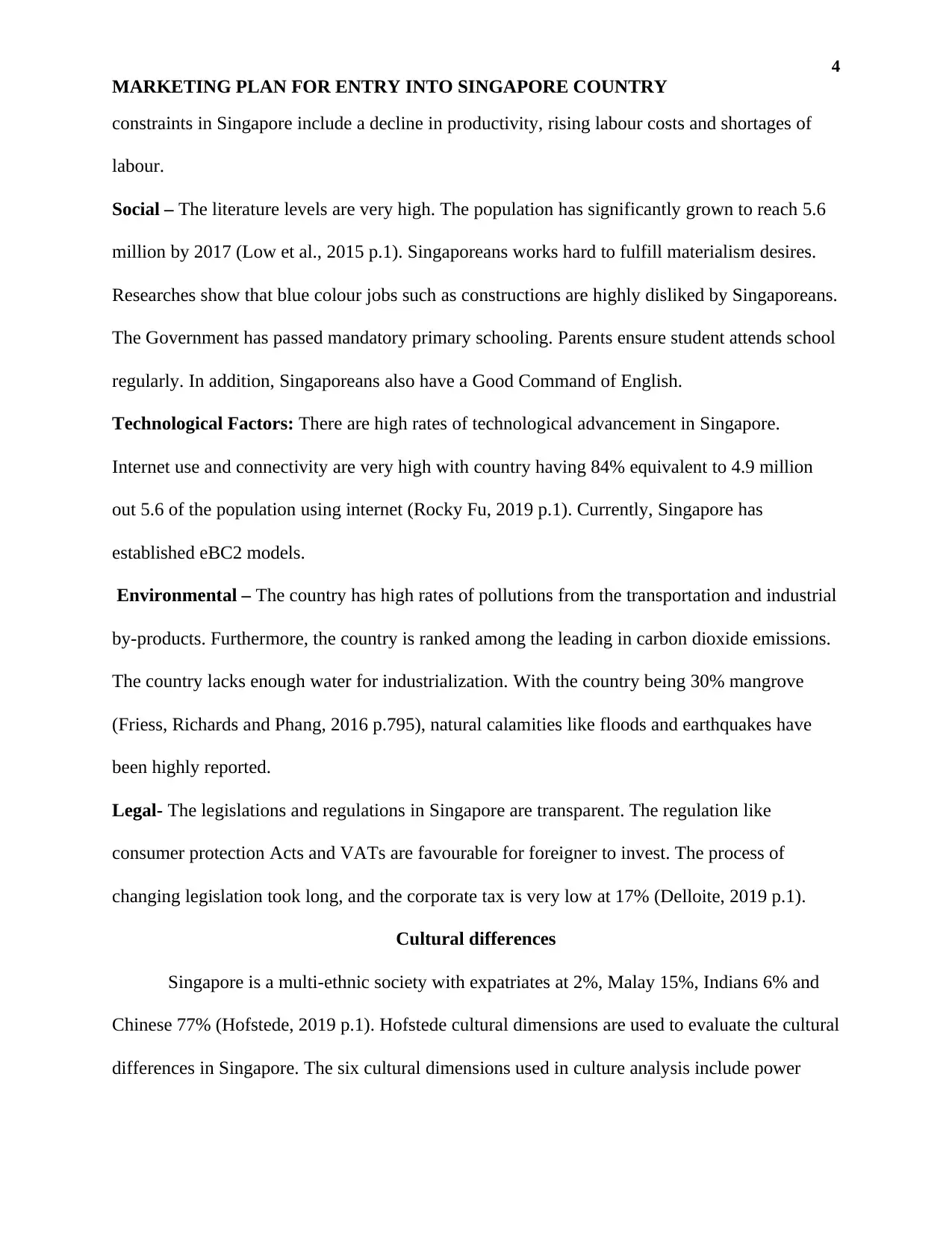
4
MARKETING PLAN FOR ENTRY INTO SINGAPORE COUNTRY
constraints in Singapore include a decline in productivity, rising labour costs and shortages of
labour.
Social – The literature levels are very high. The population has significantly grown to reach 5.6
million by 2017 (Low et al., 2015 p.1). Singaporeans works hard to fulfill materialism desires.
Researches show that blue colour jobs such as constructions are highly disliked by Singaporeans.
The Government has passed mandatory primary schooling. Parents ensure student attends school
regularly. In addition, Singaporeans also have a Good Command of English.
Technological Factors: There are high rates of technological advancement in Singapore.
Internet use and connectivity are very high with country having 84% equivalent to 4.9 million
out 5.6 of the population using internet (Rocky Fu, 2019 p.1). Currently, Singapore has
established eBC2 models.
Environmental – The country has high rates of pollutions from the transportation and industrial
by-products. Furthermore, the country is ranked among the leading in carbon dioxide emissions.
The country lacks enough water for industrialization. With the country being 30% mangrove
(Friess, Richards and Phang, 2016 p.795), natural calamities like floods and earthquakes have
been highly reported.
Legal- The legislations and regulations in Singapore are transparent. The regulation like
consumer protection Acts and VATs are favourable for foreigner to invest. The process of
changing legislation took long, and the corporate tax is very low at 17% (Delloite, 2019 p.1).
Cultural differences
Singapore is a multi-ethnic society with expatriates at 2%, Malay 15%, Indians 6% and
Chinese 77% (Hofstede, 2019 p.1). Hofstede cultural dimensions are used to evaluate the cultural
differences in Singapore. The six cultural dimensions used in culture analysis include power
MARKETING PLAN FOR ENTRY INTO SINGAPORE COUNTRY
constraints in Singapore include a decline in productivity, rising labour costs and shortages of
labour.
Social – The literature levels are very high. The population has significantly grown to reach 5.6
million by 2017 (Low et al., 2015 p.1). Singaporeans works hard to fulfill materialism desires.
Researches show that blue colour jobs such as constructions are highly disliked by Singaporeans.
The Government has passed mandatory primary schooling. Parents ensure student attends school
regularly. In addition, Singaporeans also have a Good Command of English.
Technological Factors: There are high rates of technological advancement in Singapore.
Internet use and connectivity are very high with country having 84% equivalent to 4.9 million
out 5.6 of the population using internet (Rocky Fu, 2019 p.1). Currently, Singapore has
established eBC2 models.
Environmental – The country has high rates of pollutions from the transportation and industrial
by-products. Furthermore, the country is ranked among the leading in carbon dioxide emissions.
The country lacks enough water for industrialization. With the country being 30% mangrove
(Friess, Richards and Phang, 2016 p.795), natural calamities like floods and earthquakes have
been highly reported.
Legal- The legislations and regulations in Singapore are transparent. The regulation like
consumer protection Acts and VATs are favourable for foreigner to invest. The process of
changing legislation took long, and the corporate tax is very low at 17% (Delloite, 2019 p.1).
Cultural differences
Singapore is a multi-ethnic society with expatriates at 2%, Malay 15%, Indians 6% and
Chinese 77% (Hofstede, 2019 p.1). Hofstede cultural dimensions are used to evaluate the cultural
differences in Singapore. The six cultural dimensions used in culture analysis include power
Paraphrase This Document
Need a fresh take? Get an instant paraphrase of this document with our AI Paraphraser
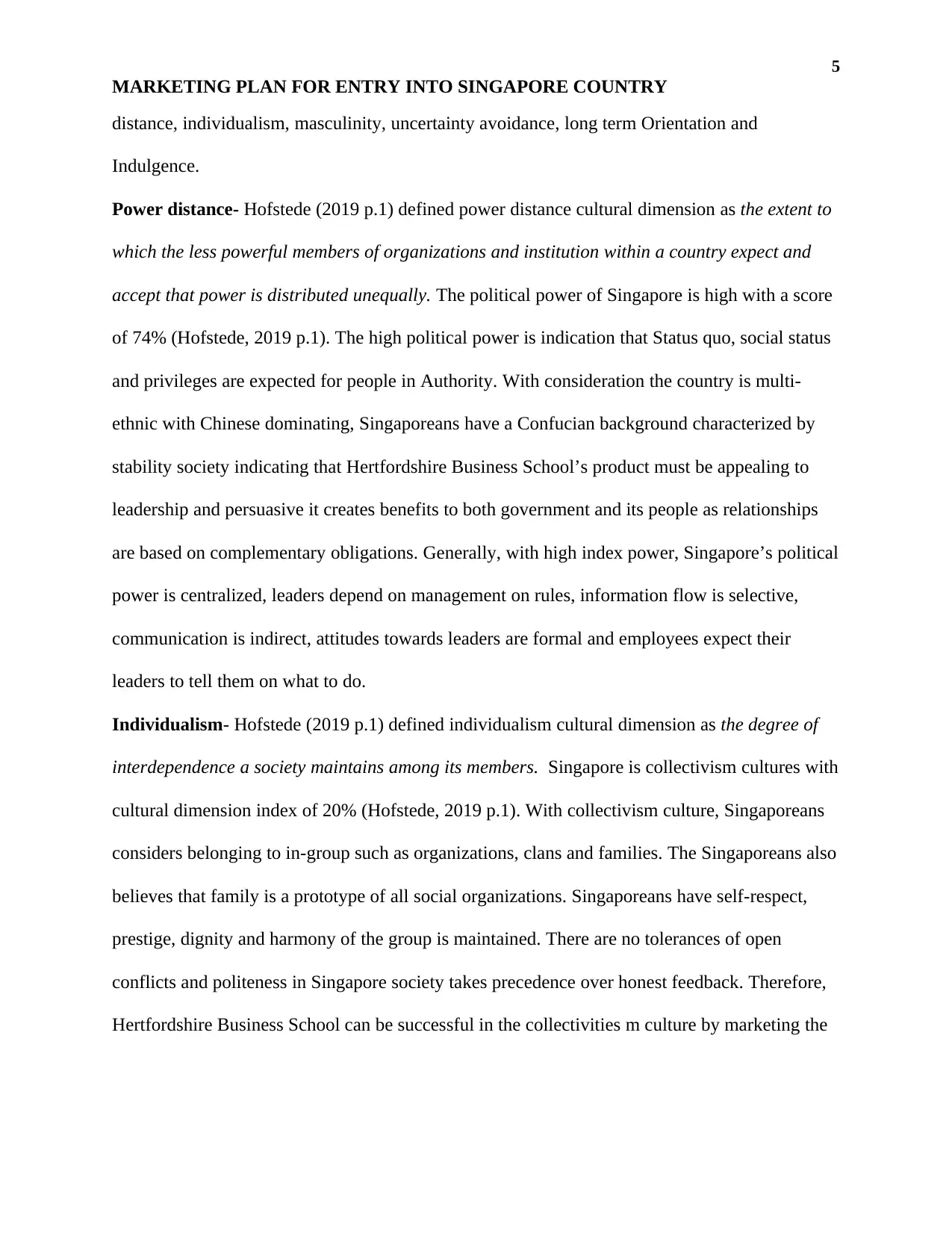
5
MARKETING PLAN FOR ENTRY INTO SINGAPORE COUNTRY
distance, individualism, masculinity, uncertainty avoidance, long term Orientation and
Indulgence.
Power distance- Hofstede (2019 p.1) defined power distance cultural dimension as the extent to
which the less powerful members of organizations and institution within a country expect and
accept that power is distributed unequally. The political power of Singapore is high with a score
of 74% (Hofstede, 2019 p.1). The high political power is indication that Status quo, social status
and privileges are expected for people in Authority. With consideration the country is multi-
ethnic with Chinese dominating, Singaporeans have a Confucian background characterized by
stability society indicating that Hertfordshire Business School’s product must be appealing to
leadership and persuasive it creates benefits to both government and its people as relationships
are based on complementary obligations. Generally, with high index power, Singapore’s political
power is centralized, leaders depend on management on rules, information flow is selective,
communication is indirect, attitudes towards leaders are formal and employees expect their
leaders to tell them on what to do.
Individualism- Hofstede (2019 p.1) defined individualism cultural dimension as the degree of
interdependence a society maintains among its members. Singapore is collectivism cultures with
cultural dimension index of 20% (Hofstede, 2019 p.1). With collectivism culture, Singaporeans
considers belonging to in-group such as organizations, clans and families. The Singaporeans also
believes that family is a prototype of all social organizations. Singaporeans have self-respect,
prestige, dignity and harmony of the group is maintained. There are no tolerances of open
conflicts and politeness in Singapore society takes precedence over honest feedback. Therefore,
Hertfordshire Business School can be successful in the collectivities m culture by marketing the
MARKETING PLAN FOR ENTRY INTO SINGAPORE COUNTRY
distance, individualism, masculinity, uncertainty avoidance, long term Orientation and
Indulgence.
Power distance- Hofstede (2019 p.1) defined power distance cultural dimension as the extent to
which the less powerful members of organizations and institution within a country expect and
accept that power is distributed unequally. The political power of Singapore is high with a score
of 74% (Hofstede, 2019 p.1). The high political power is indication that Status quo, social status
and privileges are expected for people in Authority. With consideration the country is multi-
ethnic with Chinese dominating, Singaporeans have a Confucian background characterized by
stability society indicating that Hertfordshire Business School’s product must be appealing to
leadership and persuasive it creates benefits to both government and its people as relationships
are based on complementary obligations. Generally, with high index power, Singapore’s political
power is centralized, leaders depend on management on rules, information flow is selective,
communication is indirect, attitudes towards leaders are formal and employees expect their
leaders to tell them on what to do.
Individualism- Hofstede (2019 p.1) defined individualism cultural dimension as the degree of
interdependence a society maintains among its members. Singapore is collectivism cultures with
cultural dimension index of 20% (Hofstede, 2019 p.1). With collectivism culture, Singaporeans
considers belonging to in-group such as organizations, clans and families. The Singaporeans also
believes that family is a prototype of all social organizations. Singaporeans have self-respect,
prestige, dignity and harmony of the group is maintained. There are no tolerances of open
conflicts and politeness in Singapore society takes precedence over honest feedback. Therefore,
Hertfordshire Business School can be successful in the collectivities m culture by marketing the
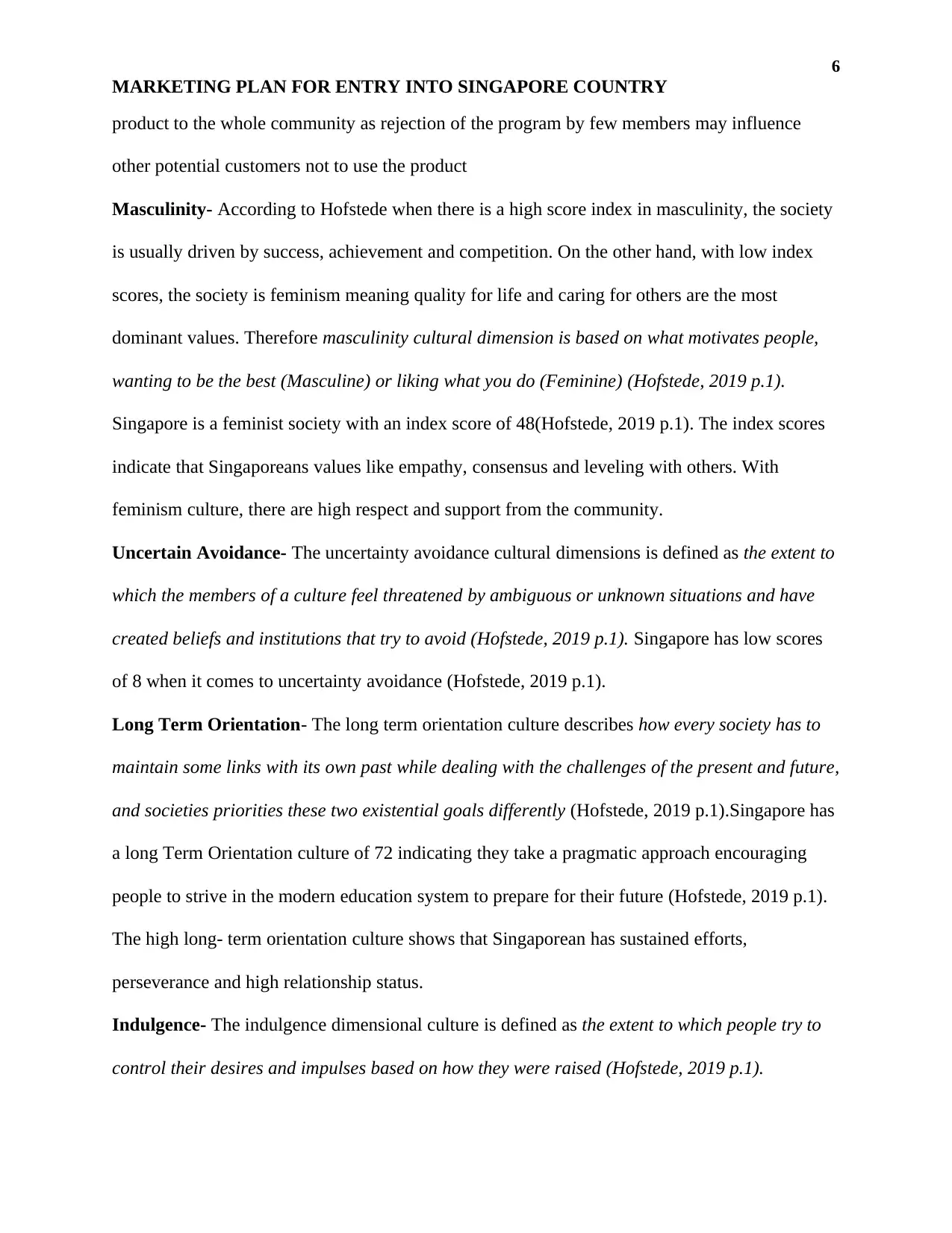
6
MARKETING PLAN FOR ENTRY INTO SINGAPORE COUNTRY
product to the whole community as rejection of the program by few members may influence
other potential customers not to use the product
Masculinity- According to Hofstede when there is a high score index in masculinity, the society
is usually driven by success, achievement and competition. On the other hand, with low index
scores, the society is feminism meaning quality for life and caring for others are the most
dominant values. Therefore masculinity cultural dimension is based on what motivates people,
wanting to be the best (Masculine) or liking what you do (Feminine) (Hofstede, 2019 p.1).
Singapore is a feminist society with an index score of 48(Hofstede, 2019 p.1). The index scores
indicate that Singaporeans values like empathy, consensus and leveling with others. With
feminism culture, there are high respect and support from the community.
Uncertain Avoidance- The uncertainty avoidance cultural dimensions is defined as the extent to
which the members of a culture feel threatened by ambiguous or unknown situations and have
created beliefs and institutions that try to avoid (Hofstede, 2019 p.1). Singapore has low scores
of 8 when it comes to uncertainty avoidance (Hofstede, 2019 p.1).
Long Term Orientation- The long term orientation culture describes how every society has to
maintain some links with its own past while dealing with the challenges of the present and future,
and societies priorities these two existential goals differently (Hofstede, 2019 p.1).Singapore has
a long Term Orientation culture of 72 indicating they take a pragmatic approach encouraging
people to strive in the modern education system to prepare for their future (Hofstede, 2019 p.1).
The high long- term orientation culture shows that Singaporean has sustained efforts,
perseverance and high relationship status.
Indulgence- The indulgence dimensional culture is defined as the extent to which people try to
control their desires and impulses based on how they were raised (Hofstede, 2019 p.1).
MARKETING PLAN FOR ENTRY INTO SINGAPORE COUNTRY
product to the whole community as rejection of the program by few members may influence
other potential customers not to use the product
Masculinity- According to Hofstede when there is a high score index in masculinity, the society
is usually driven by success, achievement and competition. On the other hand, with low index
scores, the society is feminism meaning quality for life and caring for others are the most
dominant values. Therefore masculinity cultural dimension is based on what motivates people,
wanting to be the best (Masculine) or liking what you do (Feminine) (Hofstede, 2019 p.1).
Singapore is a feminist society with an index score of 48(Hofstede, 2019 p.1). The index scores
indicate that Singaporeans values like empathy, consensus and leveling with others. With
feminism culture, there are high respect and support from the community.
Uncertain Avoidance- The uncertainty avoidance cultural dimensions is defined as the extent to
which the members of a culture feel threatened by ambiguous or unknown situations and have
created beliefs and institutions that try to avoid (Hofstede, 2019 p.1). Singapore has low scores
of 8 when it comes to uncertainty avoidance (Hofstede, 2019 p.1).
Long Term Orientation- The long term orientation culture describes how every society has to
maintain some links with its own past while dealing with the challenges of the present and future,
and societies priorities these two existential goals differently (Hofstede, 2019 p.1).Singapore has
a long Term Orientation culture of 72 indicating they take a pragmatic approach encouraging
people to strive in the modern education system to prepare for their future (Hofstede, 2019 p.1).
The high long- term orientation culture shows that Singaporean has sustained efforts,
perseverance and high relationship status.
Indulgence- The indulgence dimensional culture is defined as the extent to which people try to
control their desires and impulses based on how they were raised (Hofstede, 2019 p.1).
⊘ This is a preview!⊘
Do you want full access?
Subscribe today to unlock all pages.

Trusted by 1+ million students worldwide
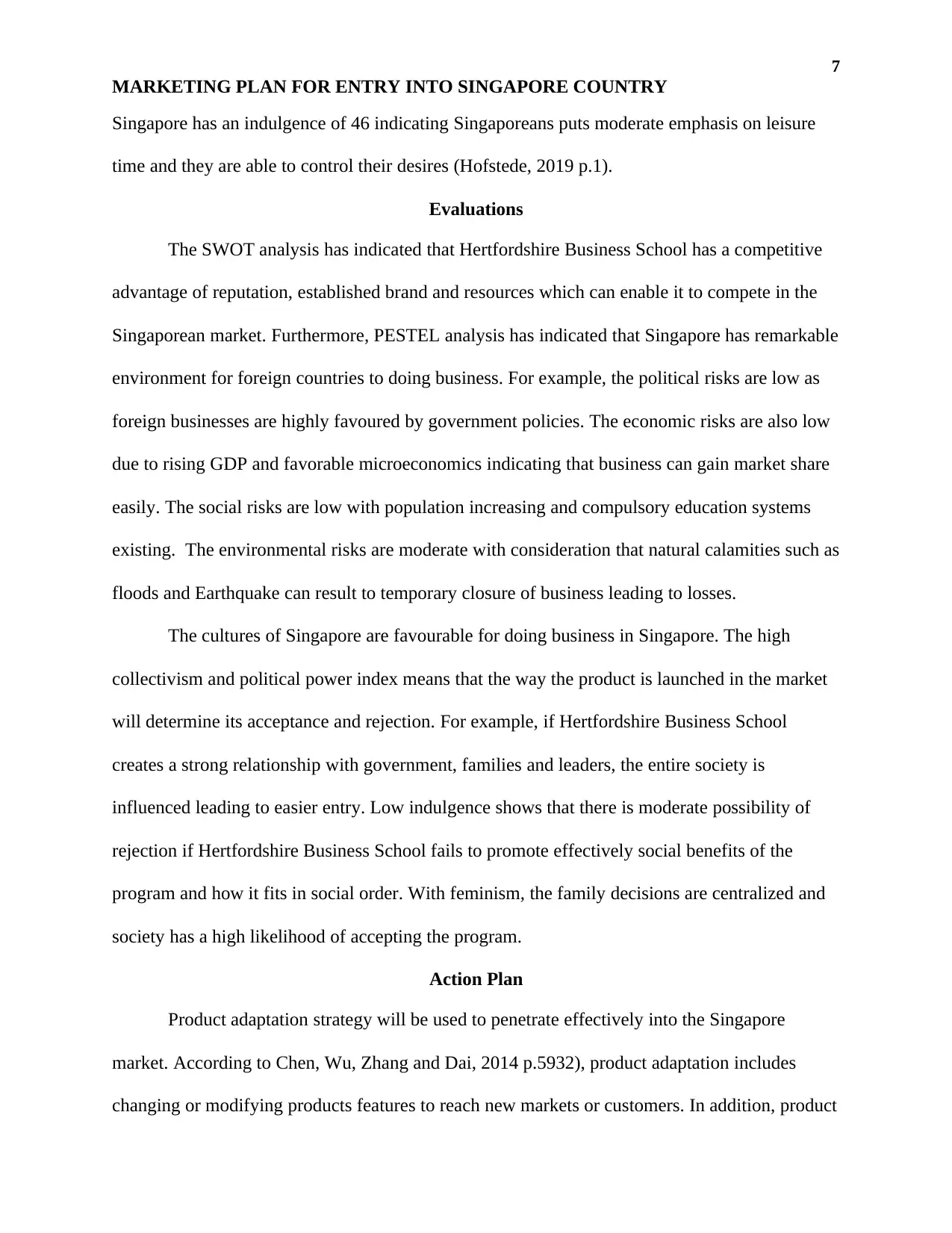
7
MARKETING PLAN FOR ENTRY INTO SINGAPORE COUNTRY
Singapore has an indulgence of 46 indicating Singaporeans puts moderate emphasis on leisure
time and they are able to control their desires (Hofstede, 2019 p.1).
Evaluations
The SWOT analysis has indicated that Hertfordshire Business School has a competitive
advantage of reputation, established brand and resources which can enable it to compete in the
Singaporean market. Furthermore, PESTEL analysis has indicated that Singapore has remarkable
environment for foreign countries to doing business. For example, the political risks are low as
foreign businesses are highly favoured by government policies. The economic risks are also low
due to rising GDP and favorable microeconomics indicating that business can gain market share
easily. The social risks are low with population increasing and compulsory education systems
existing. The environmental risks are moderate with consideration that natural calamities such as
floods and Earthquake can result to temporary closure of business leading to losses.
The cultures of Singapore are favourable for doing business in Singapore. The high
collectivism and political power index means that the way the product is launched in the market
will determine its acceptance and rejection. For example, if Hertfordshire Business School
creates a strong relationship with government, families and leaders, the entire society is
influenced leading to easier entry. Low indulgence shows that there is moderate possibility of
rejection if Hertfordshire Business School fails to promote effectively social benefits of the
program and how it fits in social order. With feminism, the family decisions are centralized and
society has a high likelihood of accepting the program.
Action Plan
Product adaptation strategy will be used to penetrate effectively into the Singapore
market. According to Chen, Wu, Zhang and Dai, 2014 p.5932), product adaptation includes
changing or modifying products features to reach new markets or customers. In addition, product
MARKETING PLAN FOR ENTRY INTO SINGAPORE COUNTRY
Singapore has an indulgence of 46 indicating Singaporeans puts moderate emphasis on leisure
time and they are able to control their desires (Hofstede, 2019 p.1).
Evaluations
The SWOT analysis has indicated that Hertfordshire Business School has a competitive
advantage of reputation, established brand and resources which can enable it to compete in the
Singaporean market. Furthermore, PESTEL analysis has indicated that Singapore has remarkable
environment for foreign countries to doing business. For example, the political risks are low as
foreign businesses are highly favoured by government policies. The economic risks are also low
due to rising GDP and favorable microeconomics indicating that business can gain market share
easily. The social risks are low with population increasing and compulsory education systems
existing. The environmental risks are moderate with consideration that natural calamities such as
floods and Earthquake can result to temporary closure of business leading to losses.
The cultures of Singapore are favourable for doing business in Singapore. The high
collectivism and political power index means that the way the product is launched in the market
will determine its acceptance and rejection. For example, if Hertfordshire Business School
creates a strong relationship with government, families and leaders, the entire society is
influenced leading to easier entry. Low indulgence shows that there is moderate possibility of
rejection if Hertfordshire Business School fails to promote effectively social benefits of the
program and how it fits in social order. With feminism, the family decisions are centralized and
society has a high likelihood of accepting the program.
Action Plan
Product adaptation strategy will be used to penetrate effectively into the Singapore
market. According to Chen, Wu, Zhang and Dai, 2014 p.5932), product adaptation includes
changing or modifying products features to reach new markets or customers. In addition, product
Paraphrase This Document
Need a fresh take? Get an instant paraphrase of this document with our AI Paraphraser
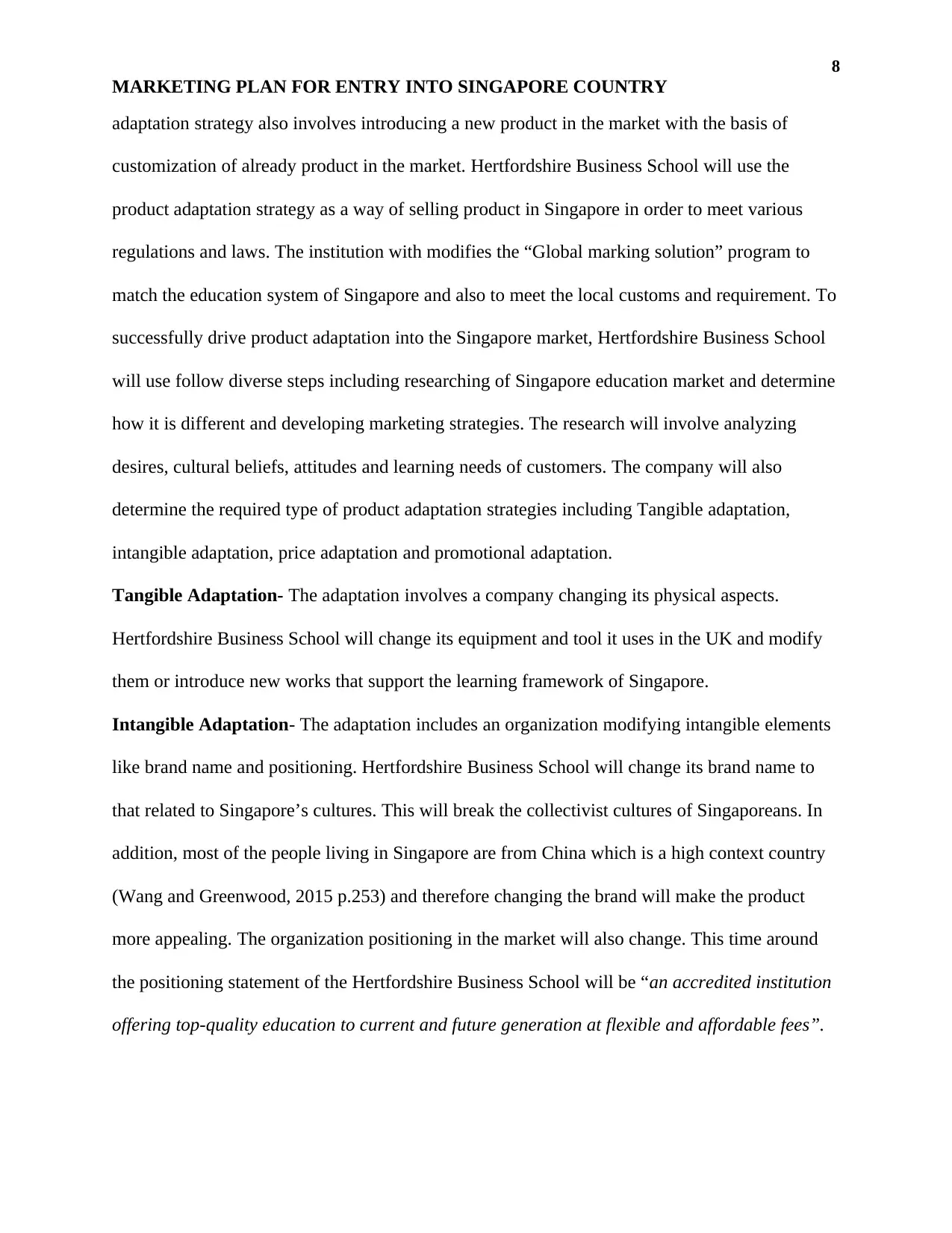
8
MARKETING PLAN FOR ENTRY INTO SINGAPORE COUNTRY
adaptation strategy also involves introducing a new product in the market with the basis of
customization of already product in the market. Hertfordshire Business School will use the
product adaptation strategy as a way of selling product in Singapore in order to meet various
regulations and laws. The institution with modifies the “Global marking solution” program to
match the education system of Singapore and also to meet the local customs and requirement. To
successfully drive product adaptation into the Singapore market, Hertfordshire Business School
will use follow diverse steps including researching of Singapore education market and determine
how it is different and developing marketing strategies. The research will involve analyzing
desires, cultural beliefs, attitudes and learning needs of customers. The company will also
determine the required type of product adaptation strategies including Tangible adaptation,
intangible adaptation, price adaptation and promotional adaptation.
Tangible Adaptation- The adaptation involves a company changing its physical aspects.
Hertfordshire Business School will change its equipment and tool it uses in the UK and modify
them or introduce new works that support the learning framework of Singapore.
Intangible Adaptation- The adaptation includes an organization modifying intangible elements
like brand name and positioning. Hertfordshire Business School will change its brand name to
that related to Singapore’s cultures. This will break the collectivist cultures of Singaporeans. In
addition, most of the people living in Singapore are from China which is a high context country
(Wang and Greenwood, 2015 p.253) and therefore changing the brand will make the product
more appealing. The organization positioning in the market will also change. This time around
the positioning statement of the Hertfordshire Business School will be “an accredited institution
offering top-quality education to current and future generation at flexible and affordable fees”.
MARKETING PLAN FOR ENTRY INTO SINGAPORE COUNTRY
adaptation strategy also involves introducing a new product in the market with the basis of
customization of already product in the market. Hertfordshire Business School will use the
product adaptation strategy as a way of selling product in Singapore in order to meet various
regulations and laws. The institution with modifies the “Global marking solution” program to
match the education system of Singapore and also to meet the local customs and requirement. To
successfully drive product adaptation into the Singapore market, Hertfordshire Business School
will use follow diverse steps including researching of Singapore education market and determine
how it is different and developing marketing strategies. The research will involve analyzing
desires, cultural beliefs, attitudes and learning needs of customers. The company will also
determine the required type of product adaptation strategies including Tangible adaptation,
intangible adaptation, price adaptation and promotional adaptation.
Tangible Adaptation- The adaptation involves a company changing its physical aspects.
Hertfordshire Business School will change its equipment and tool it uses in the UK and modify
them or introduce new works that support the learning framework of Singapore.
Intangible Adaptation- The adaptation includes an organization modifying intangible elements
like brand name and positioning. Hertfordshire Business School will change its brand name to
that related to Singapore’s cultures. This will break the collectivist cultures of Singaporeans. In
addition, most of the people living in Singapore are from China which is a high context country
(Wang and Greenwood, 2015 p.253) and therefore changing the brand will make the product
more appealing. The organization positioning in the market will also change. This time around
the positioning statement of the Hertfordshire Business School will be “an accredited institution
offering top-quality education to current and future generation at flexible and affordable fees”.
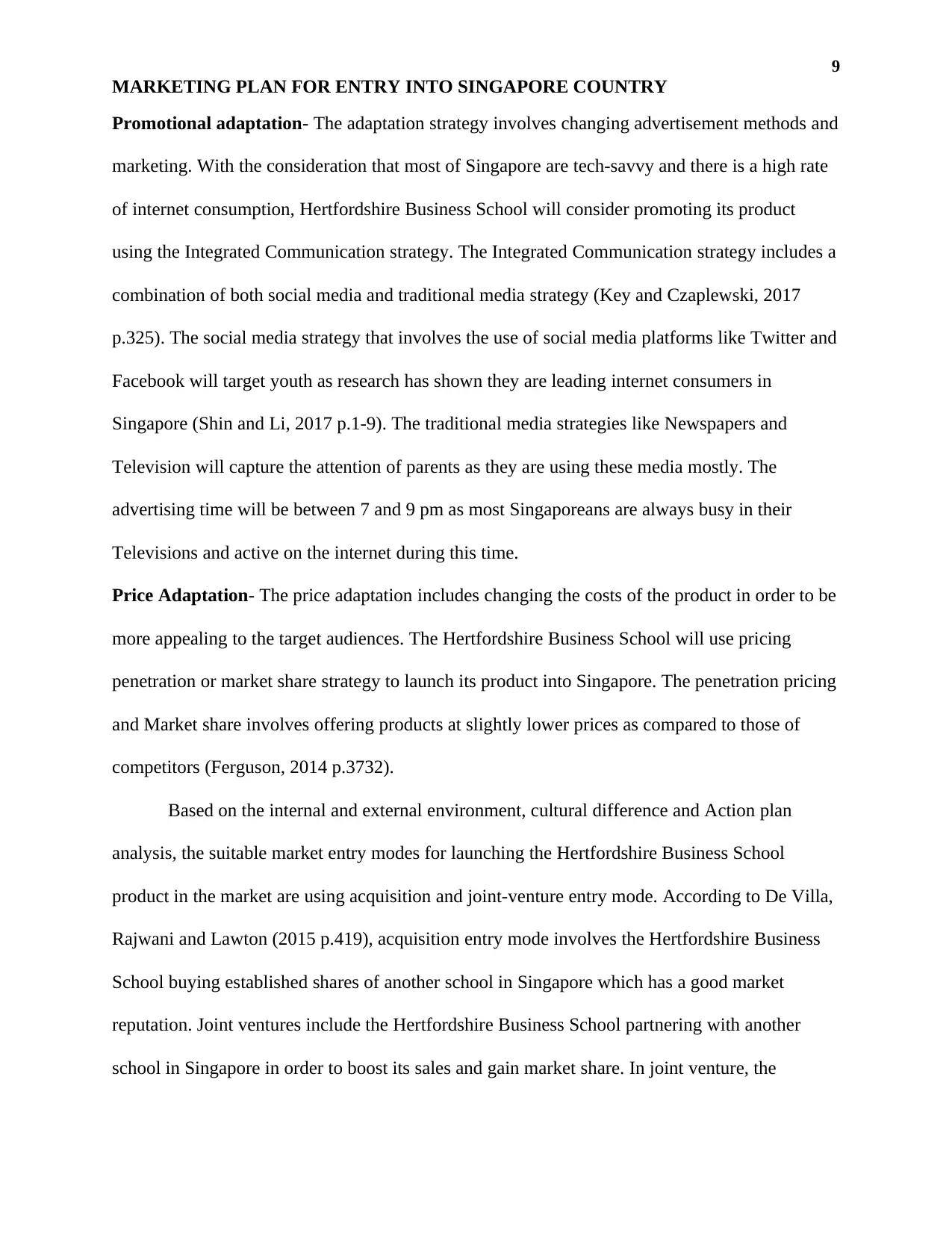
9
MARKETING PLAN FOR ENTRY INTO SINGAPORE COUNTRY
Promotional adaptation- The adaptation strategy involves changing advertisement methods and
marketing. With the consideration that most of Singapore are tech-savvy and there is a high rate
of internet consumption, Hertfordshire Business School will consider promoting its product
using the Integrated Communication strategy. The Integrated Communication strategy includes a
combination of both social media and traditional media strategy (Key and Czaplewski, 2017
p.325). The social media strategy that involves the use of social media platforms like Twitter and
Facebook will target youth as research has shown they are leading internet consumers in
Singapore (Shin and Li, 2017 p.1-9). The traditional media strategies like Newspapers and
Television will capture the attention of parents as they are using these media mostly. The
advertising time will be between 7 and 9 pm as most Singaporeans are always busy in their
Televisions and active on the internet during this time.
Price Adaptation- The price adaptation includes changing the costs of the product in order to be
more appealing to the target audiences. The Hertfordshire Business School will use pricing
penetration or market share strategy to launch its product into Singapore. The penetration pricing
and Market share involves offering products at slightly lower prices as compared to those of
competitors (Ferguson, 2014 p.3732).
Based on the internal and external environment, cultural difference and Action plan
analysis, the suitable market entry modes for launching the Hertfordshire Business School
product in the market are using acquisition and joint-venture entry mode. According to De Villa,
Rajwani and Lawton (2015 p.419), acquisition entry mode involves the Hertfordshire Business
School buying established shares of another school in Singapore which has a good market
reputation. Joint ventures include the Hertfordshire Business School partnering with another
school in Singapore in order to boost its sales and gain market share. In joint venture, the
MARKETING PLAN FOR ENTRY INTO SINGAPORE COUNTRY
Promotional adaptation- The adaptation strategy involves changing advertisement methods and
marketing. With the consideration that most of Singapore are tech-savvy and there is a high rate
of internet consumption, Hertfordshire Business School will consider promoting its product
using the Integrated Communication strategy. The Integrated Communication strategy includes a
combination of both social media and traditional media strategy (Key and Czaplewski, 2017
p.325). The social media strategy that involves the use of social media platforms like Twitter and
Facebook will target youth as research has shown they are leading internet consumers in
Singapore (Shin and Li, 2017 p.1-9). The traditional media strategies like Newspapers and
Television will capture the attention of parents as they are using these media mostly. The
advertising time will be between 7 and 9 pm as most Singaporeans are always busy in their
Televisions and active on the internet during this time.
Price Adaptation- The price adaptation includes changing the costs of the product in order to be
more appealing to the target audiences. The Hertfordshire Business School will use pricing
penetration or market share strategy to launch its product into Singapore. The penetration pricing
and Market share involves offering products at slightly lower prices as compared to those of
competitors (Ferguson, 2014 p.3732).
Based on the internal and external environment, cultural difference and Action plan
analysis, the suitable market entry modes for launching the Hertfordshire Business School
product in the market are using acquisition and joint-venture entry mode. According to De Villa,
Rajwani and Lawton (2015 p.419), acquisition entry mode involves the Hertfordshire Business
School buying established shares of another school in Singapore which has a good market
reputation. Joint ventures include the Hertfordshire Business School partnering with another
school in Singapore in order to boost its sales and gain market share. In joint venture, the
⊘ This is a preview!⊘
Do you want full access?
Subscribe today to unlock all pages.

Trusted by 1+ million students worldwide
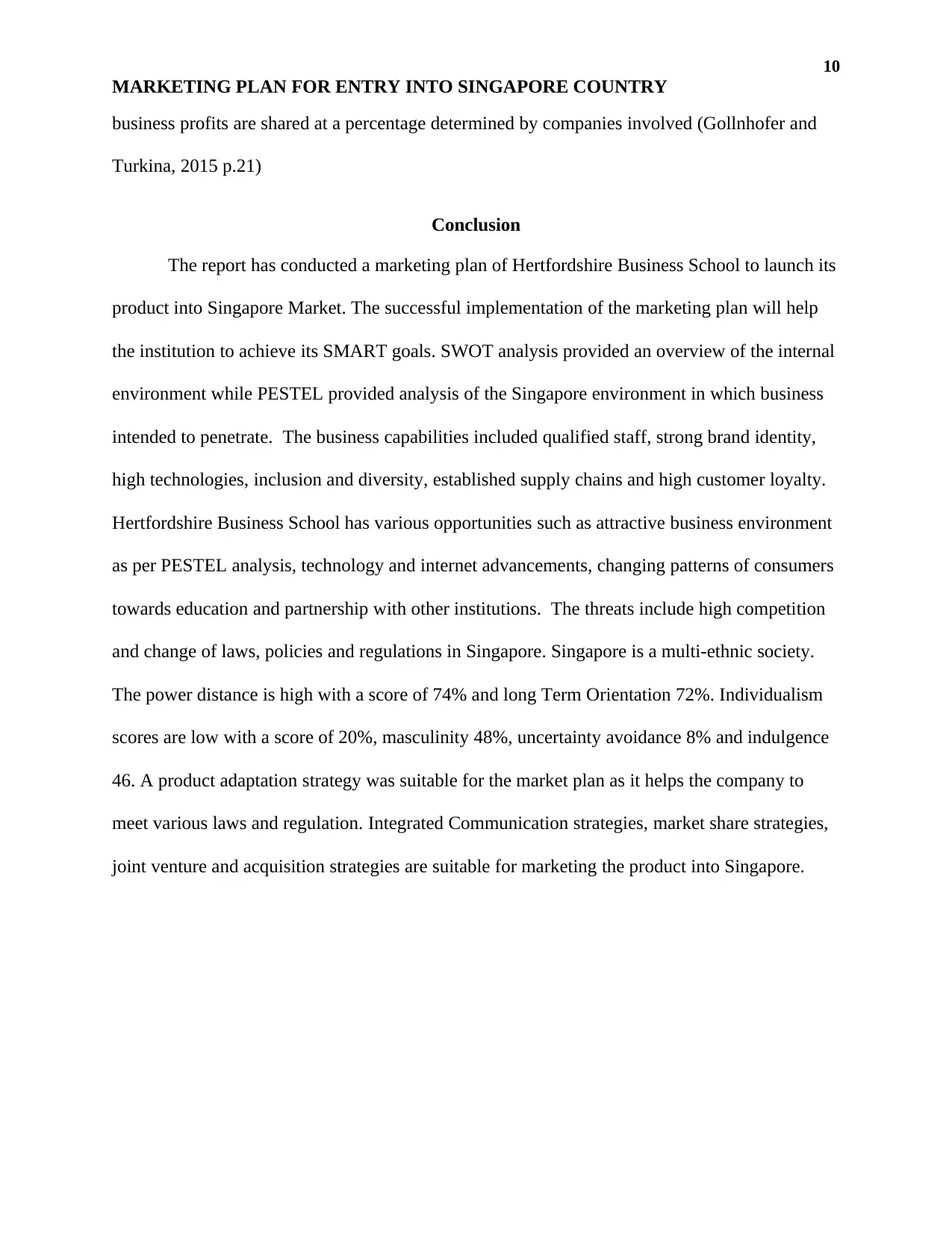
10
MARKETING PLAN FOR ENTRY INTO SINGAPORE COUNTRY
business profits are shared at a percentage determined by companies involved (Gollnhofer and
Turkina, 2015 p.21)
Conclusion
The report has conducted a marketing plan of Hertfordshire Business School to launch its
product into Singapore Market. The successful implementation of the marketing plan will help
the institution to achieve its SMART goals. SWOT analysis provided an overview of the internal
environment while PESTEL provided analysis of the Singapore environment in which business
intended to penetrate. The business capabilities included qualified staff, strong brand identity,
high technologies, inclusion and diversity, established supply chains and high customer loyalty.
Hertfordshire Business School has various opportunities such as attractive business environment
as per PESTEL analysis, technology and internet advancements, changing patterns of consumers
towards education and partnership with other institutions. The threats include high competition
and change of laws, policies and regulations in Singapore. Singapore is a multi-ethnic society.
The power distance is high with a score of 74% and long Term Orientation 72%. Individualism
scores are low with a score of 20%, masculinity 48%, uncertainty avoidance 8% and indulgence
46. A product adaptation strategy was suitable for the market plan as it helps the company to
meet various laws and regulation. Integrated Communication strategies, market share strategies,
joint venture and acquisition strategies are suitable for marketing the product into Singapore.
MARKETING PLAN FOR ENTRY INTO SINGAPORE COUNTRY
business profits are shared at a percentage determined by companies involved (Gollnhofer and
Turkina, 2015 p.21)
Conclusion
The report has conducted a marketing plan of Hertfordshire Business School to launch its
product into Singapore Market. The successful implementation of the marketing plan will help
the institution to achieve its SMART goals. SWOT analysis provided an overview of the internal
environment while PESTEL provided analysis of the Singapore environment in which business
intended to penetrate. The business capabilities included qualified staff, strong brand identity,
high technologies, inclusion and diversity, established supply chains and high customer loyalty.
Hertfordshire Business School has various opportunities such as attractive business environment
as per PESTEL analysis, technology and internet advancements, changing patterns of consumers
towards education and partnership with other institutions. The threats include high competition
and change of laws, policies and regulations in Singapore. Singapore is a multi-ethnic society.
The power distance is high with a score of 74% and long Term Orientation 72%. Individualism
scores are low with a score of 20%, masculinity 48%, uncertainty avoidance 8% and indulgence
46. A product adaptation strategy was suitable for the market plan as it helps the company to
meet various laws and regulation. Integrated Communication strategies, market share strategies,
joint venture and acquisition strategies are suitable for marketing the product into Singapore.
Paraphrase This Document
Need a fresh take? Get an instant paraphrase of this document with our AI Paraphraser
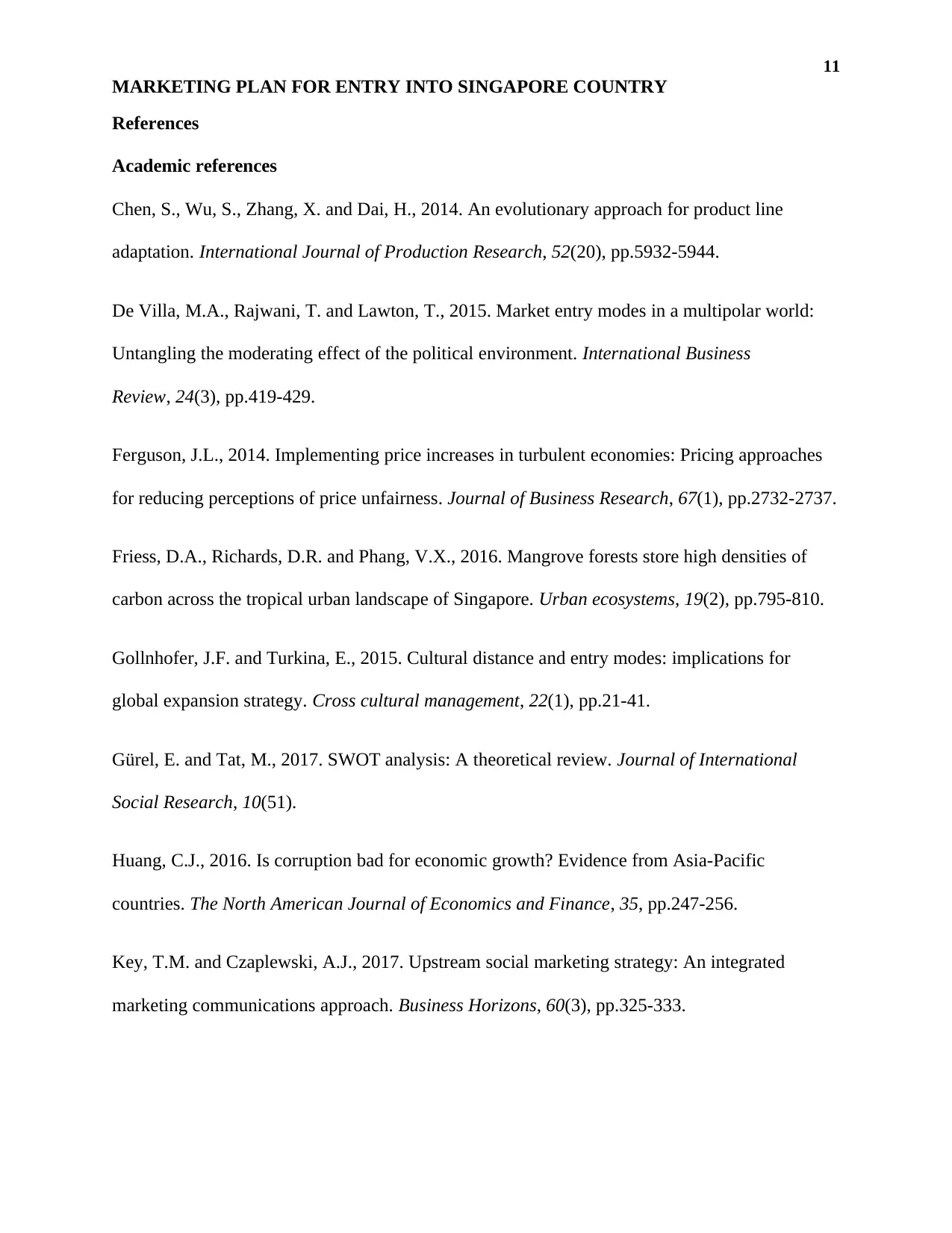
11
MARKETING PLAN FOR ENTRY INTO SINGAPORE COUNTRY
References
Academic references
Chen, S., Wu, S., Zhang, X. and Dai, H., 2014. An evolutionary approach for product line
adaptation. International Journal of Production Research, 52(20), pp.5932-5944.
De Villa, M.A., Rajwani, T. and Lawton, T., 2015. Market entry modes in a multipolar world:
Untangling the moderating effect of the political environment. International Business
Review, 24(3), pp.419-429.
Ferguson, J.L., 2014. Implementing price increases in turbulent economies: Pricing approaches
for reducing perceptions of price unfairness. Journal of Business Research, 67(1), pp.2732-2737.
Friess, D.A., Richards, D.R. and Phang, V.X., 2016. Mangrove forests store high densities of
carbon across the tropical urban landscape of Singapore. Urban ecosystems, 19(2), pp.795-810.
Gollnhofer, J.F. and Turkina, E., 2015. Cultural distance and entry modes: implications for
global expansion strategy. Cross cultural management, 22(1), pp.21-41.
Gürel, E. and Tat, M., 2017. SWOT analysis: A theoretical review. Journal of International
Social Research, 10(51).
Huang, C.J., 2016. Is corruption bad for economic growth? Evidence from Asia-Pacific
countries. The North American Journal of Economics and Finance, 35, pp.247-256.
Key, T.M. and Czaplewski, A.J., 2017. Upstream social marketing strategy: An integrated
marketing communications approach. Business Horizons, 60(3), pp.325-333.
MARKETING PLAN FOR ENTRY INTO SINGAPORE COUNTRY
References
Academic references
Chen, S., Wu, S., Zhang, X. and Dai, H., 2014. An evolutionary approach for product line
adaptation. International Journal of Production Research, 52(20), pp.5932-5944.
De Villa, M.A., Rajwani, T. and Lawton, T., 2015. Market entry modes in a multipolar world:
Untangling the moderating effect of the political environment. International Business
Review, 24(3), pp.419-429.
Ferguson, J.L., 2014. Implementing price increases in turbulent economies: Pricing approaches
for reducing perceptions of price unfairness. Journal of Business Research, 67(1), pp.2732-2737.
Friess, D.A., Richards, D.R. and Phang, V.X., 2016. Mangrove forests store high densities of
carbon across the tropical urban landscape of Singapore. Urban ecosystems, 19(2), pp.795-810.
Gollnhofer, J.F. and Turkina, E., 2015. Cultural distance and entry modes: implications for
global expansion strategy. Cross cultural management, 22(1), pp.21-41.
Gürel, E. and Tat, M., 2017. SWOT analysis: A theoretical review. Journal of International
Social Research, 10(51).
Huang, C.J., 2016. Is corruption bad for economic growth? Evidence from Asia-Pacific
countries. The North American Journal of Economics and Finance, 35, pp.247-256.
Key, T.M. and Czaplewski, A.J., 2017. Upstream social marketing strategy: An integrated
marketing communications approach. Business Horizons, 60(3), pp.325-333.
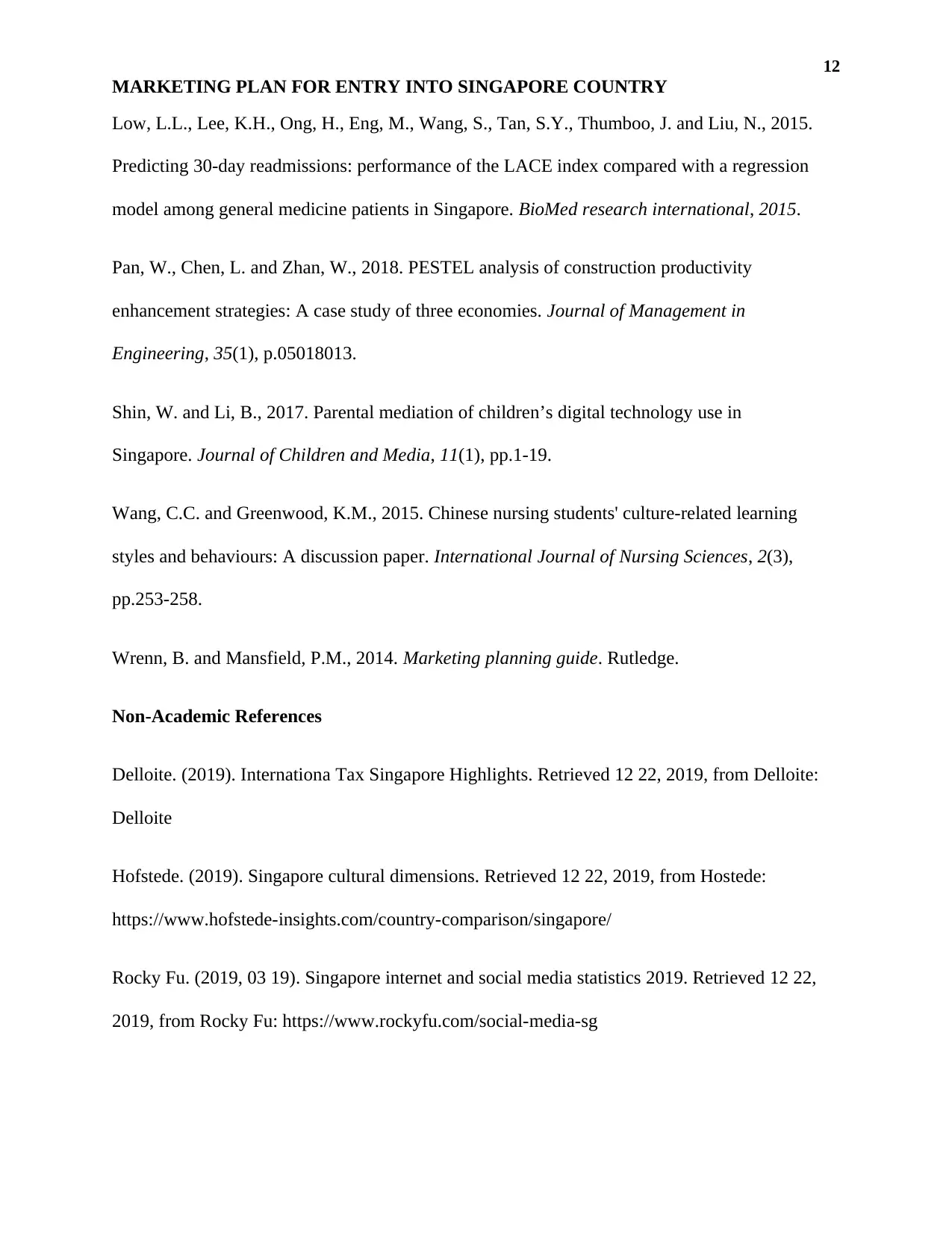
12
MARKETING PLAN FOR ENTRY INTO SINGAPORE COUNTRY
Low, L.L., Lee, K.H., Ong, H., Eng, M., Wang, S., Tan, S.Y., Thumboo, J. and Liu, N., 2015.
Predicting 30-day readmissions: performance of the LACE index compared with a regression
model among general medicine patients in Singapore. BioMed research international, 2015.
Pan, W., Chen, L. and Zhan, W., 2018. PESTEL analysis of construction productivity
enhancement strategies: A case study of three economies. Journal of Management in
Engineering, 35(1), p.05018013.
Shin, W. and Li, B., 2017. Parental mediation of children’s digital technology use in
Singapore. Journal of Children and Media, 11(1), pp.1-19.
Wang, C.C. and Greenwood, K.M., 2015. Chinese nursing students' culture-related learning
styles and behaviours: A discussion paper. International Journal of Nursing Sciences, 2(3),
pp.253-258.
Wrenn, B. and Mansfield, P.M., 2014. Marketing planning guide. Rutledge.
Non-Academic References
Delloite. (2019). Internationa Tax Singapore Highlights. Retrieved 12 22, 2019, from Delloite:
Delloite
Hofstede. (2019). Singapore cultural dimensions. Retrieved 12 22, 2019, from Hostede:
https://www.hofstede-insights.com/country-comparison/singapore/
Rocky Fu. (2019, 03 19). Singapore internet and social media statistics 2019. Retrieved 12 22,
2019, from Rocky Fu: https://www.rockyfu.com/social-media-sg
MARKETING PLAN FOR ENTRY INTO SINGAPORE COUNTRY
Low, L.L., Lee, K.H., Ong, H., Eng, M., Wang, S., Tan, S.Y., Thumboo, J. and Liu, N., 2015.
Predicting 30-day readmissions: performance of the LACE index compared with a regression
model among general medicine patients in Singapore. BioMed research international, 2015.
Pan, W., Chen, L. and Zhan, W., 2018. PESTEL analysis of construction productivity
enhancement strategies: A case study of three economies. Journal of Management in
Engineering, 35(1), p.05018013.
Shin, W. and Li, B., 2017. Parental mediation of children’s digital technology use in
Singapore. Journal of Children and Media, 11(1), pp.1-19.
Wang, C.C. and Greenwood, K.M., 2015. Chinese nursing students' culture-related learning
styles and behaviours: A discussion paper. International Journal of Nursing Sciences, 2(3),
pp.253-258.
Wrenn, B. and Mansfield, P.M., 2014. Marketing planning guide. Rutledge.
Non-Academic References
Delloite. (2019). Internationa Tax Singapore Highlights. Retrieved 12 22, 2019, from Delloite:
Delloite
Hofstede. (2019). Singapore cultural dimensions. Retrieved 12 22, 2019, from Hostede:
https://www.hofstede-insights.com/country-comparison/singapore/
Rocky Fu. (2019, 03 19). Singapore internet and social media statistics 2019. Retrieved 12 22,
2019, from Rocky Fu: https://www.rockyfu.com/social-media-sg
⊘ This is a preview!⊘
Do you want full access?
Subscribe today to unlock all pages.

Trusted by 1+ million students worldwide
1 out of 13
Related Documents
Your All-in-One AI-Powered Toolkit for Academic Success.
+13062052269
info@desklib.com
Available 24*7 on WhatsApp / Email
![[object Object]](/_next/static/media/star-bottom.7253800d.svg)
Unlock your academic potential
Copyright © 2020–2025 A2Z Services. All Rights Reserved. Developed and managed by ZUCOL.





